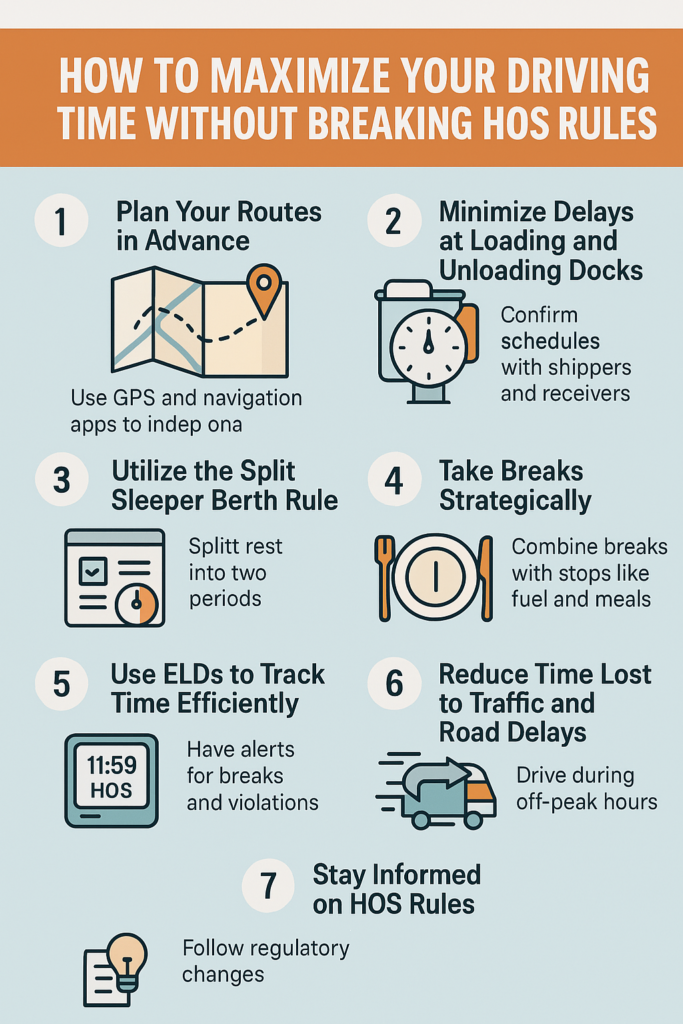In the trucking industry, time is money. The more efficiently you use your driving hours, the more profitable your routes become. However, balancing maximum driving time with compliance under the Hours of Service (HOS) regulations can be challenging. Exceeding HOS limits can lead to hefty fines, downtime, and safety risks.
To help you stay compliant while making the most of your available driving hours, we’ve compiled essential strategies that optimize your time behind the wheel. Whether you’re a company driver or an owner-operator, these tips will help you increase efficiency, manage rest breaks wisely, and avoid unnecessary delays.
For additional support, check out the Hours of Service service.
1. Plan Your Routes in Advance
Proper route planning is one of the most effective ways to maximize driving time. Unexpected detours, construction zones, or heavy traffic can eat into your available hours, forcing you to take unplanned breaks or extend your trip unnecessarily.
How to Plan Effectively:
- Use GPS and trucking-specific navigation apps to find the most efficient routes.
- Check weather forecasts and road conditions before starting your trip.
- Identify and schedule stops at truck-friendly rest areas for planned breaks.
- Account for fuel stops, weigh stations, and loading/unloading times.
By planning ahead, you reduce wasted time and ensure smoother, more efficient trips.
2. Utilize the Split Sleeper Berth Rule
One of the most overlooked ways to extend driving time legally is by using the split sleeper berth provision. This rule allows you to break your required 10-hour off-duty period into two separate segments, giving you more flexibility.
How the Split Sleeper Rule Works:
- Instead of a full 10-hour break, you can split your rest period into two separate periods (e.g., 8/2 or 7/3 hours).
- These two breaks must add up to at least 10 hours but don’t count against your 14-hour on-duty window.
- This flexibility helps you adjust rest periods around peak traffic times or long loading/unloading waits.
Understanding and properly utilizing this rule can help you increase daily driving hours while staying compliant.
3. Minimize Delays at Loading and Unloading Docks
Time spent waiting at docks counts against your HOS limits and reduces your driving time. To minimize delays, try the following:
Tips for Reducing Wait Time:
- Communicate with shippers and receivers ahead of time to confirm schedules.
- Arrive early or during less busy hours to avoid congestion.
- Use drop-and-hook services where available instead of waiting for live loads.
- Keep documentation ready to speed up the check-in and loading process.
Less time waiting at docks means more time on the road, maximizing your efficiency.
4. Take Breaks Strategically
HOS regulations require drivers to take a 30-minute break after 8 hours of driving. Instead of treating it as lost time, you can use it wisely to improve productivity.
Smart Break Management:
- Combine your break with fuel stops, meals, or rest stops to avoid extra downtime.
- Park at a rest area close to your next route to reduce post-break detours.
- If you’re feeling tired before the 8-hour mark, take an early break to reset energy levels.
Using your breaks wisely prevents unnecessary stops later and keeps you refreshed and alert.
5. Use Electronic Logging Devices (ELDs) to Track Time Efficiently
Since the ELD mandate, most drivers must use electronic logging devices (ELDs) to track driving hours accurately. ELDs help avoid accidental HOS violations and ensure you make the most of your available driving time.
How ELDs Improve Time Management:
- Alerts and reminders help you track upcoming rest breaks.
- Automated tracking eliminates time wasted on manual log entries.
- HOS violation warnings help you avoid unintentional infractions.
By using an ELD effectively, you can optimize every minute of your available driving time.
6. Reduce Time Lost to Traffic and Road Delays
Traffic congestion can eat away at your available driving hours and cause unnecessary stress. While it’s impossible to avoid traffic entirely, you can take steps to reduce its impact.
Ways to Avoid Traffic Delays:
- Drive during off-peak hours whenever possible.
- Use real-time traffic monitoring apps to adjust routes on the go.
- Take alternate highways instead of congested city roads.
- If traffic is unavoidable, time your required breaks to coincide with slow periods.
Smart scheduling and real-time traffic awareness can help you maintain a steady pace and prevent wasted hours.
7. Stay Up to Date on HOS Regulations and Changes
FMCSA occasionally updates Hours of Service regulations, and staying informed can help you make better use of your driving hours.
How to Stay Updated:
- Follow FMCSA announcements for rule changes.
- Attend HOS compliance training sessions.
- Check industry news sources and trucking forums regularly.
- Consult with compliance experts if you have any questions.
Knowing your rights and responsibilities under HOS laws ensures you don’t miss out on valuable driving time due to outdated practices.

Final Thoughts
Maximizing your driving time while staying compliant with HOS regulations requires smart planning, efficient rest breaks, and real-time adjustments. By following these strategies—planning routes, using split sleeper berths, minimizing delays, and leveraging ELDs—you can legally increase your hours behind the wheel and improve your earnings.
For expert assistance with compliance, visit the Hours of Service service and keep your trucking business running smoothly.





